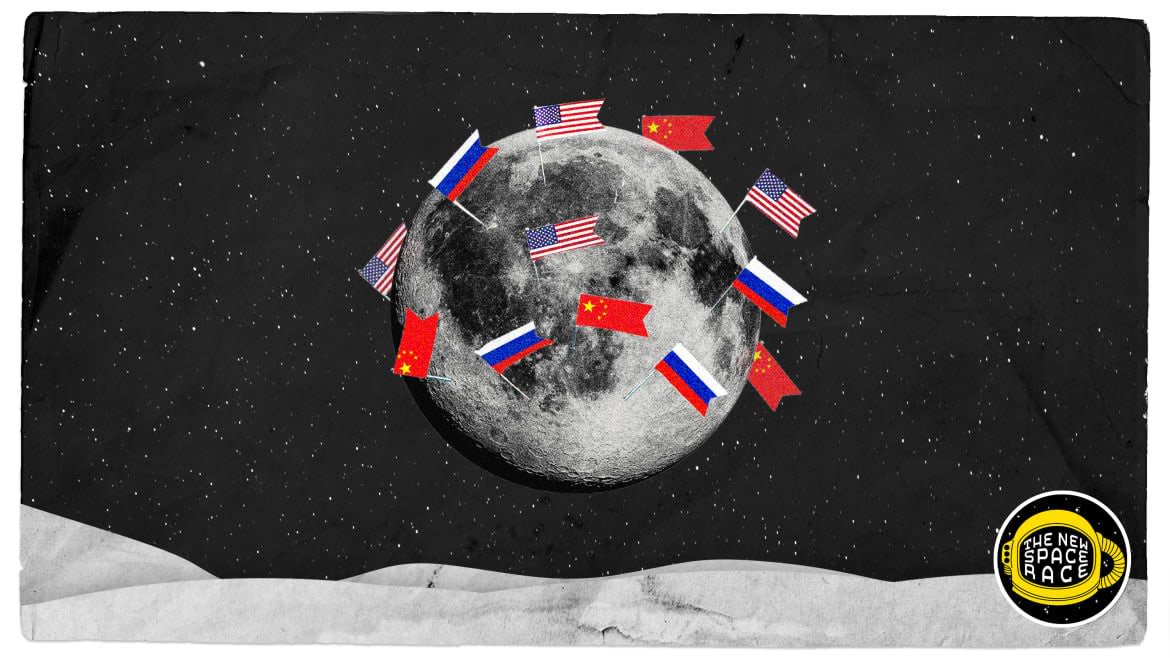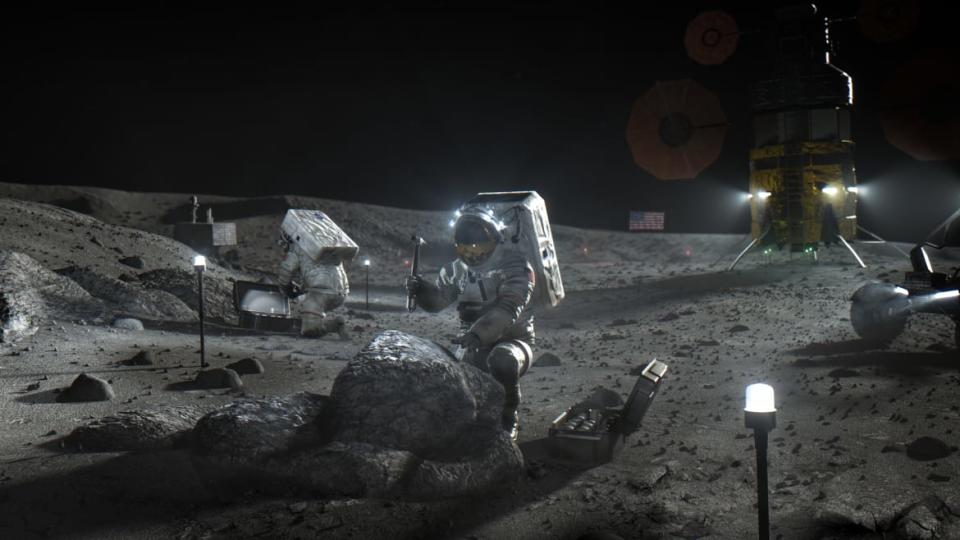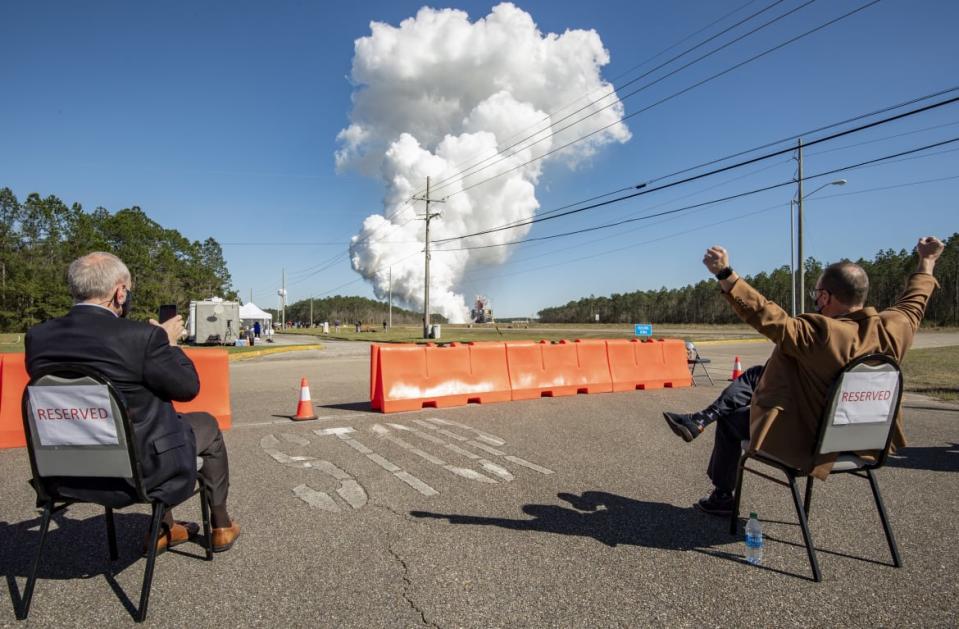Whoever Controls the Moon Controls the Solar System

In 1961, U.S. President John F. Kennedy declared that his nation would be the first to land a man on the moon. That ambitious goal would later be fulfilled as two NASA astronauts took wobbly steps across the lunar surface on July 20, 1969, much to the dismay of Russia’s own space program leaders.
More than 60 years later, a new space race to the moon has begun, albeit with much higher stakes and brand new players ready to make the 238,855-mile journey. This time, the race to the moon is about much more than just planting a flag on its dusty surface. Getting to the moon first could also mean calling dibs on its limited resources, and controlling a permanent gateway to take humans to Mars—and beyond.
Whether it’s NASA, China, Russia, or a consortium of private companies that end up dominating the moon, laying claim to the lunar surface isn’t really about the moon anyway—it’s about who gets easier access to the rest of the solar system.
Everyone’s Got an Agenda
James Rice, a senior scientist at the School of Earth and Space Exploration at Arizona State University, remembers growing up with the Apollo program and getting bitten by the space bug as he watched the 1969 moon landing unfold on television.
“As a kid, I saw that happening and I wanted to be a part of it,” Rice told The Daily Beast. “That’s basically why I’m in this career today.”
As Rice reflected on the current space race, he recognized some key differences. “Things have really changed dramatically in terms of the technology and the players that are out there,” he said. “This is not the moon we thought of during the Apollo days.” Scientists have learned so much more about the moon through more detailed analysis of lunar samples, as well as several missions that have probed exactly what might be sitting on the moon’s surface and remain hidden deep underground.
Though we have known for over a decade that the moon is probably teeming with reserves of water ice, NASA announced just last year that it had found the best evidence yet that water trapped in icy pockets were far more spread out across the lunar surface than previously believed. The discovery further fueled the idea of building a permanent base on the moon, which astronauts could then use to reach Mars and other celestial destinations.

Conceptual art for a NASA-led astronaut base involving water ice prospecting and mining.
Why is this such a big deal? Water is a precious resource for space travelers—not just for astronauts to drink, but also to turn into rocket fuel to use to blast off.
Remember your grade-school science here: Water is made of hydrogen and oxygen. Hydrogen is known to be the most efficient rocket propellant whereas oxygen can be combined by fuel to create combustion. The ability to break down all that water ice on the moon means you have access to both of its constituent elements—an enormous supply of rocket fuel. (And as an added bonus, you can use any excess oxygen as breathable air for astronauts.)
Finding these resources on the moon is much better than transporting them from Earth. Packing resources to space comes at a hefty price—it costs about $10,000 just to launch a payload weighing a single pound into Earth’s orbit, according to NASA. It could be far less costly to use what the moon has to offer to build a lunar pitstop to cosmic destinations.
“I think the moon has been placed as this midpoint, or first step towards Mars,” Casey Dreier, senior space policy adviser at The Planetary Society, told The Daily Beast. “It’s not an end destination.”
In other words, going back to the moon is not really about the moon, at least not entirely. It’s a gateway to truly larger space ambitions. That’s why Artemis—NASA’s new lunar exploration program—has been consistently touted not as simply a redux of Apollo, but rather the initial foundation for a permanent presence on the moon.

Acting NASA Administrator Steve Jurczyk, left, and Rick Gilbrech, director of NASA's Stennis Space Center, right, watch as the core stage for the first flight of NASAs Space Launch System rocket undergoes a second hot fire test in the B-2 Test Stand on March 18.
Martha Hess, the director for human exploration and spaceflight at the Aerospace Corporation, a nonprofit for technical guidance on space missions, echoed those sentiments. “This time, the moon is a training ground, and Mars is the destination,” she told The Daily Beast.
Today’s space race is also not merely between competing nations and political ideologies. It also involves private companies trying to pursue profits. “We are at a unique point in time where our economy and technology are aligned, allowing for private and commercial investment in space based capabilities,” said Hess. “This investment takes the pressure off government agencies to sustain the industry.”
Private companies like SpaceX and Blue Origin are also looking beyond the moon. SpaceX CEO Elon Musk has an obsessive vision of going to Mars and terraforming the planet to make it suitable for human colonization. Blue Origin’s Jeff Bezos is looking to be a dominating player in the field of commercial space travel, transporting (probably very wealthy) citizens to the moon or beyond.
“Private companies have their own long term goals that exist outside of the national space program,” Dreier said. “They’ll do whatever NASA asks them to do, they don’t care whether NASA is going to the moon or Mars.”
Water, Water, Everywhere
Something that will define the upcoming moon race is the fact that not every region on the moon is equal in value. “There are limited places to go, and it’s all about location,” Rice said.
Just as the California gold rush of the 19th century was defined by where the gold was found, so too will the water rush to the moon be defined by where the water is stored. The U.S. is looking to build its lunar base at the moon’s south pole, where there is thought to be a wealth of water ice reserves.
Moreover, the south pole is a wellspring for fulfilling energy needs: It’s exposed to more sunshine than anywhere else on the moon, which would fuel solar panels and supply power to the base.

Li Xianhua, China Academy of Sciences academician and Institute of Geology, speaks during a press conference in Beijing on Oct. 19.
And with no clear space laws currently in place over ownership of objects in space, lunar resources may very well come down to whoever calls dibs first.
Who else wants to build a base on the moon’s south pole? For starters, there’s China, which recently announced long-term plans to build a base on the moon with Russia. Its more distant goal, of course, is to send a crewed mission to Mars by the year 2033.
The Chinese Lunar Exploration Program, or the Chang’e Project, is relatively new to the scene but has already made great strides. In Jan. 2019, the country’s Chang’e-4 lunar probe was the first spacecraft in history to safely land on the far side of the moon. In Dec. 2020, the Chang’e-5 mission returned samples from the lunar surface. Those new moon rocks are already paying off in new scientific revelations. .
China’s space agency recently approved three more missions to the moon, targeting—you guessed it—the lunar south pole. The nation’s space program is hoping to land astronauts on the moon by the year 2030. Down the line, we may see Chinese and American astronauts hanging out on the moon at the same time.
The Finish Line
Nevertheless, China and Russia don’t pose much competition to the U.S. as long as NASA doesn’t dawdle on its way back to the moon. “China is absolutely working on building up its capability,” Dreier said. “But I’d say they’re at least a decade behind, if not more, compared to the U.S. capability.”
First up on NASA’s agenda is Artemis I, an uncrewed test flight to the moon that is meant to debut the brand new Space Launch System (the biggest rocket system ever built) and the Orion crew capsule that will eventually take astronauts back to the moon. Launching tentatively in April, Artemis I will simply orbit the moon and come back to Earth. It won’t be until Artemis III, set to launch in 2025 (if you’re an optimist), that we’ll finally see human boots make it to the lunar surface.
Hess does believe, however, that China has one advantage over the U.S. that it could exploit to make speedy progress.
“China has the benefit of being able to establish a long-term plan and funding, which allows them the ability to chip away at their 30-50-100 year vision,” Hess said. “We don’t have that luxury; our plans are good for a presidential term, and our budgets are appropriated annually so our programs start, stop and starve.” Long-term exploration of the solar system isn’t actually something that’s crystallized in U.S. budgets for decades to come.
NASA estimates that the Artemis program will cost $86 billion by 2025. The current U.S. administration has made a $24.8 billion fiscal 2022 budget request for NASA to cover the return to the moon.
During the first space race, the agency spent $28 billion to land the first humans on the moon, which is about $280 billion when adjusted for inflation, according to The Planetary Society.
As the space program for each of the space race participants begins to take shape, policy makers are realizing that they need to update the laws at hand to better govern the new era of space exploration that’s about to launch.
Regardless of who gets to plant space boots on the moon next, there is an overarching benefit to human exploration as a whole.
“There's more to it than that because there's an inspiration to it that you can't put a price tag on,” Rice said. “It does something to you when you walk out there and look at the moon and now there are people out there doing something, that just resonates.”
Get the Daily Beast's biggest scoops and scandals delivered right to your inbox. Sign up now.
Stay informed and gain unlimited access to the Daily Beast's unmatched reporting. Subscribe now.

